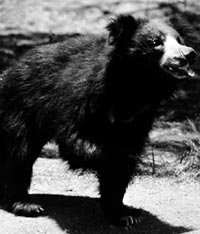
Then and now: Of wild and not so wild animalsAnimals Far And Near by Gamini de S. Punchihewa. Reviewed by Dr. Ranjen Fernando. Published by NAVRANG - New Delhi. Price Rs. 900. This latest book by Gamini de S. Punchihewa not only describes the significant features of wild fauna and flora in Sri Lanka but also traces the evolution and the natural history of the changing habitats and its influence on various species of animals and plants in the jungle habitats. The book is divided in to several chapters with each of them focusing on families of animals while comparing the adaptations of the individual species to the specific environment in which they thrive. The chapters on the Sloth Bear, the Spotted Deer (aristocrats of the animal race), the monkeys and whales delve into the historical, cultural, and social significance of these respective animals. Conforming to the name of the book, the author illustrates both metaphorical and the physical interpretations of this terminology “far and near”.
“Elephants in antiquity and now” refers to the export of elephants by Royal decree and the duties of the Gajanayake Nilame while also tracing the social and cultural roles of elephants in different countries, over the centuries. The relevant and interesting aspects of the elephant are woven into the chapter in such a way that this book will command the interest of a variety of readers. Descriptions of the Gal Oya elephant drive and the Deduru Oya drive, both of which were failures, add finesse to this chapter which is a comprehensive monogram on elephants. Punchihewa traces the history of the Wildlife & Nature Protection Society which originated as the Game Protection Society of Ceylon and the contributions this society made towards the establishment of the current National Parks. How Henry Engelbrecht, a Boer prisoner of war, ended up as the first “Game-Keeper” of the Yala National Park makes interesting reading, revealing the origin of this popular park. Authentic historical data is also in corporated into the text through quotes from our historic chronicles of 200 B.C., stone inscriptions at Narlar Kulam from P.E.P. Deraniyagala and references to King Louis XVI of France requesting two small elephants for the French Royal Palace. The chapter on “Cats – Domesticated and Wild” tells the story of the Egyptians, who revered cats, and where an Egyptian goddess is epitomized as a woman with the head of a cat. Readers will find the story about the ability of cats to predict impending rain, more than a mere folk-tale associated with cats.
The chapter on dogs reiterates the close association with man and his best friend with ample references to Punchihewa’s own pet Inky. Here too he delves into the attitudes of different races such as the Egyptians and the Jews, towards these animals but does not forget to point out that dog flesh is nevertheless considered a delicacy in some other countries. The chapter on “Sea Mammals” quotes Sir Emerson Tenent who explains the perception of a mermaid The fatalities, caused to the Dugongs by oil spills during the Gulf war have not been overlooked by the author in this chapter. Crocodiles, monitor lizards and snakes too are described with special attention to related folk-lore such as the legendary ‘Mapillas’ who are believed to suck the blood from their victim while hanging from the roof. Herpetologist Anslem de Silva’s plates illustrating serpents add interest to this chapter, which is of much educational value too. In addition to these descriptions of species and families of animals, associated anecdotes on wildlife habitats and the descriptions of the socio-cultural changes that occurred during the 30 years when Mr. Punchihewa worked for the Gal Oya Development Board, the text gives an insight to the life of the colonists who were introduced to this region. Using his very close rapport with the pioneering colonists of this valley Punchihewa analyses the attitude, the hopes and the aspirations of the people and the peers who introduced this life-style in our country and rejuvenated an agricultural revolution. This reveals interesting aspects to the current debate on large scale colonization schemes and the effect of social reforms. In his inimitable style the author has inter-woven legend, folklore, anthropology, wildlife, natural history, irrigations systems, colonization and several related disciplines into this single book which will make interesting reading to a wide cross-section of our readers. Priced at Rs. 900, it would also be an ideal gift for anyone interested in studying the changing rural lifestyles and the influence of urbanization on society. |
|| Front
Page | News | Editorial | Columns | Sports | Plus | Financial
Times | International | Mirror | TV
Times | Funday
Times || |
| |
Copyright
2007 Wijeya
Newspapers Ltd.Colombo. Sri Lanka. |

